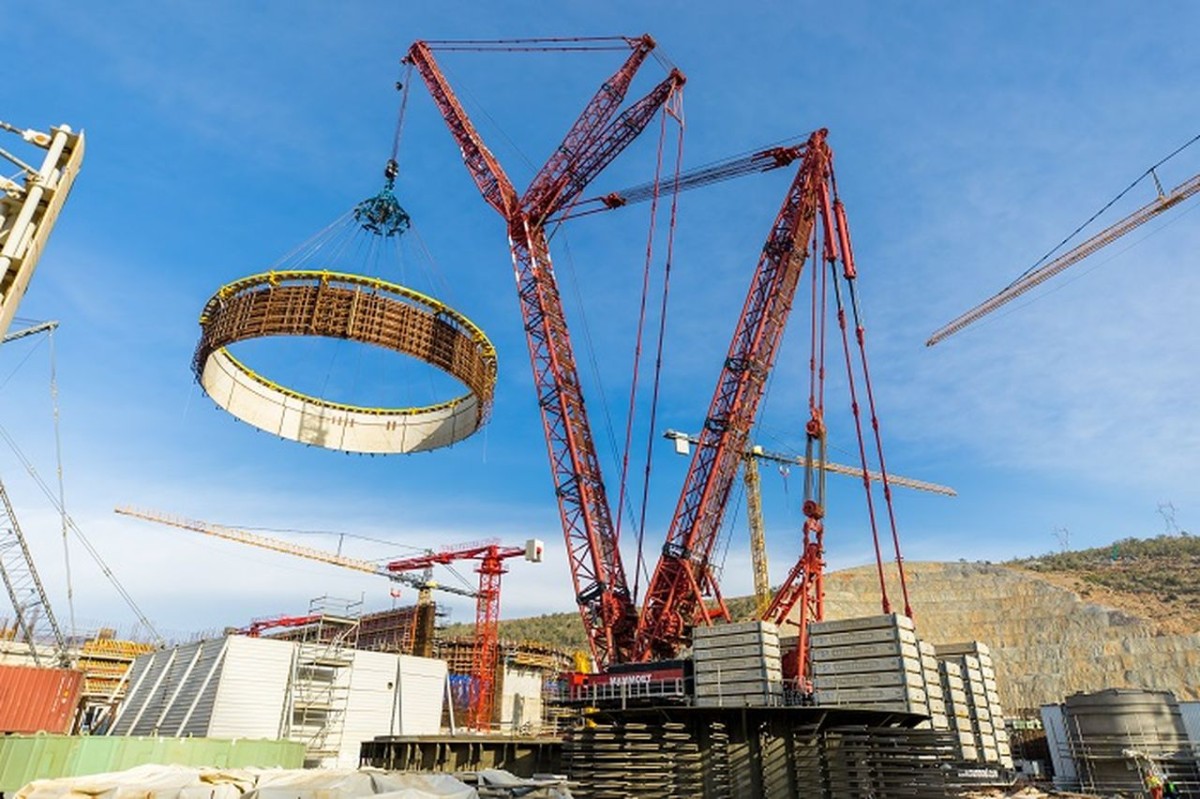 The fourth tier of the internal containment (VZO) has been installed at unit 2 of the Akkuyu NPP under construction in Turkiye, which is one of the main elements of the safety system. The VZO,made of a special concrete mix with a steel lining, ensures the tightness of the reactor compartment. The internal radius is 22 metres, the height eight metres, and the weight more than 144 tonnes.
The fourth tier of the internal containment (VZO) has been installed at unit 2 of the Akkuyu NPP under construction in Turkiye, which is one of the main elements of the safety system. The VZO,made of a special concrete mix with a steel lining, ensures the tightness of the reactor compartment. The internal radius is 22 metres, the height eight metres, and the weight more than 144 tonnes.
During three months, a longline was assembled near the unit 2 construction site. The installation was carried out using a Liebherr LTM 1300 truck crane and two hydraulic devices. To install the fourth tier, a special traverse was developed, which protects the prefabricated structure from deformation during movement by a crane. Sergey Butskikh, Rosatom First Deputy General Director & Director of the Akkuyu NPP under construction explained that the inner containment consists of structures of various shapes.
“The fourth tier is the last of the cylindrical tiers, and then the domed part will be installed, which is scheduled for the summer of this year,” he said. “We rely on our many years of construction experience, this allows us to save time and use the available resources as efficiently as possible. Next, it is planned to weld the third and fourth tiers, and to reinforce and install embedded parts, including elements of a transport gateway and a personnel gateway.”
The reactor buildings at the Akkuyu NPP power units are equipped with double containment. The outer protective shell is formed from reinforced concrete and designed to withstand extreme external influences including earthquakes of up to 9 points, tsunamis, hurricanes, as well as their combinations.
Akkuyu, Turkiye's first NPP, will eventually host four Russian-designed VVER-1200 reactors. The pouring of first concrete for unit 1 took place in April 2018, for unit 2 in June 2020, for unit 3 in March 2021, and for unit 4 in July 2022. Completion of unit 1 is expected in the third quarter of 2023. Rosatom is constructing the reactors according to a build-own-operate model. To date, the project is fully funded by the Russian side. However, Rosatom has the right to sell a share of up to 49% in the project to other investors.
Construction and installation work on site is underway simultaneously at all the main and auxiliary facilities. These include four power units, onshore hydraulic structures, power distribution system, administrative buildings, training centre, and physical protection facilities. All stages of construction are closely monitored by independent inspection organisations and the Turkish Nuclear Regulatory Agency (NDK).
Meanwhile, AEM Technologies (part of Rosatom’s mechanical engineering division Atomenergomash) has manufactured and shipped a pressure compensator designed for unit 2. The pressure compensator is part of the main equipment of the NPP reactor hall. It is designed to create and maintain the required pressure in the primary circuit of the reactor. The device is a thick-walled vessel with a wall thickness of 165 mm, the internal volume of the product is 79 cubic metres, and the weight more than 180 tonnes.
The body of the apparatus consists of four cylindrical shells and two elliptical bottoms. A cladding layer of another metal has been applied to the workpieces using a thermomechanical method to protect the product from corrosion. During manufacture, the lower and upper semi-hulls of the product are assembled separately. After assembly and welding of the thick-walled shells and bottoms, the product is subjected to heat treatment and is maintained in a furnace for 10 hours at temperatures up to 650 degrees Celsius.
The component will be transported by road from the plant to the port at the Tsimlyansk reservoir, and will then be loaded onto a barge and sent to Turkiye by sea – a distance of about 3,000 km.
Image: The fourth tier of the internal containment being lifted into place by a Liebherr LTM 1300 truck crane (courtesy of Akkuyu Nuclear)



